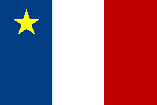Charles A. Coignard writes about...
“The Cricket and the Ant”
Mr. Webb:
I am absolutely delighted to have this opportunity to thank you for having made one of my favorites easily available. While visiting a friend yesterday, La Cigale entered the conversation briefly, resulting in this message to you.
Somewhere along in my education, I tried to memorize it but never succeeded in mastering the whole fable. And now, in my 80’s, my memory is not functioning on all of its cylinders, or as it is better expressed in a language which obviously we both love, La mémoire est la faculté qui oublie [Memory is what we have that forgets].
Your “poetic license” interested me. In south Louisiana, where I have lived all of my life, French is still spoken, especially in small rural communities, and is a way of life dating back to the arrival of the French in New Orleans and the “Cajuns” after Le Grand Dérangement. If you are from this area, I am telling you nothing new.
Here many (most?) of us call the cigale a locust. In his monumental book A Dictionary of the Cajun Language, the late Reverend Monsignor Jules O. Daigle, a Catholic priest, gave the following definition: “cigale, n.m. Mosquito hawk. Cigale de bois — katydid, locust, 17-year locust, cicada.”
I had to chuckle when reading your reference to “English-speaking readers.” When I was young, it was the custom (and maybe still is) to refer to non-French speaking people as “Américains,” no matter their nationality or heritage.
Thanks again from someone who is proud to be a “Creole” – a descendant of French settlers of the Gulf Coast preserving their speech and culture.
Charles A. Coignard
Copyright © 2008 by Charles A. Coignard
Bonjour, Monsieur Coignard,
Thank you for your complimentary and informative letter!
|
In Nova Scotia, particularly, the Acadian flag is displayed on many homes. It’s the French tricolor with the maris stella. |

|
|
|
Louisiana has a flag for “Acadiana.” This flag adds the French fleur-de-lys and a Spanish castle. |

|
Don

